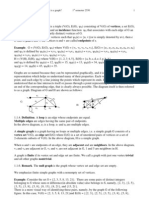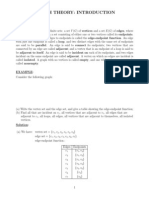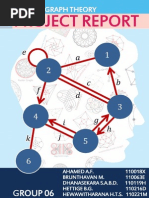Assignment Number 1
Uploaded by
Qaiser MuhammadAssignment Number 1
Uploaded by
Qaiser MuhammadGraph Theory (First Assignment)
Submitted by: Qaiser Muhammad Abdur Rehman
Student No: 11917024
1.4.1: Every simple diagram of n vertices is isomorphic in a subgraph of Kn.
Proof: Set G is any simple graph with n vertices, and Kn's vertices are n, And Kn
is a complete diagram, by the definition of G is a subplot of Kn. by G's
arbitrariness, Propositions can be proved.
1.5.3: If a k-regular bipartite graph with k > 0 has bipartition (X, Y), then |x| =
|Y|.
Proof: Take k regular even graph G (V, E), defined by the even graph and
handshake theorem, then The two endpoints of e . . . are in X and Y,
respectively.
Suppose the s.X. sm, smh.com.au s n, sg. ≥ m and n (m, n are positive integers),
so there must be a little v0 in Y, so that d (v0) and d (v) are k, and G is the
contradiction of k regular.
The same, take the g. There is also the presence of v0', so that d (v0') is k. so m is
n, i.e. |x| = |Y|.
1.5.10: The edge graph of a graph G is the graph with vertex set E(G) in which
two vertices are joined if and only if they are adjacent edges in G. Show that, if
G is simple
(a) the edge graph of G has ε(G) vertices and ∑ (𝑑𝐺(𝑣)
2
) edges;
𝑣∈𝑉(𝐺)
(b) the edge graph of K5 is isomorphic to the complement of the graph featured
in exercise 1.2.6.
Proof: (a) First, as can be seen by the definition of the edge graph, G's edge
chart H contains all of G's Vertex, so the number of vertices in its edge chart is
equal to g.
G is a simple graph, and its edge chart H is also it The subplot.
By the handshake theorem, the number of edges of H is equal to the degree and
half of its vertex, That is, ∑ (𝑑𝐺(𝑣)
2
)
𝑣∈𝑉(𝐺)
You might also like
- Bms College of Engineering, Bangalore-19 Department of MathematicsNo ratings yetBms College of Engineering, Bangalore-19 Department of Mathematics13 pages
- Graph Theory: (Graph Terminology and Handshaking Theorem)No ratings yetGraph Theory: (Graph Terminology and Handshaking Theorem)19 pages
- PG_M.Sc._Mathematics_31141 Graph TheoryNo ratings yetPG_M.Sc._Mathematics_31141 Graph Theory96 pages
- Ma3354 DM Unit 3 Part A, B Question and AnswerNo ratings yetMa3354 DM Unit 3 Part A, B Question and Answer9 pages
- CS6702 Graph Theory and Applications Unit I IntroductionNo ratings yetCS6702 Graph Theory and Applications Unit I Introduction25 pages
- A Dynamic Algorithm For Line Graph Recognition: L (G) L (G)No ratings yetA Dynamic Algorithm For Line Graph Recognition: L (G) L (G)2 pages
- Discrete Mathematics: Jemsheena P S Assistant ProfessorNo ratings yetDiscrete Mathematics: Jemsheena P S Assistant Professor68 pages
- Discrete Mathematics Unit 5 Graph TheoryNo ratings yetDiscrete Mathematics Unit 5 Graph Theory58 pages
- Jaan Islam Divergent Statecrafts Islam and Modern State Nov 2024No ratings yetJaan Islam Divergent Statecrafts Islam and Modern State Nov 202431 pages
- Math 68 - Spring 2014 - Practice Problems With Solutions - : G Is Loopless andNo ratings yetMath 68 - Spring 2014 - Practice Problems With Solutions - : G Is Loopless and11 pages
































































